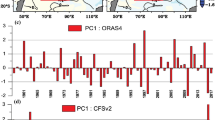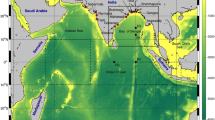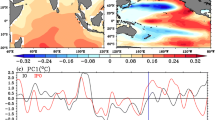Abstract
The first two leading modes of interannual variability of sea surface temperature in the Tropical Indian Ocean (TIO) are governed by El Niño Southern Oscillation and Indian Ocean Dipole (IOD) respectively. TIO subsurface however does not co-vary with the surface. The patterns of the first mode of TIO subsurface temperature variability and their vertical structure are found to closely resemble the patterns of IOD and El Niño co-occurrence years. These co-occurrence years are characterized by a north–south subsurface dipole rather than a conventional IOD forced east–west dipole. This subsurface dipole is forced by wind stress curl anomalies, driven mainly by meridional shear in the zonal wind anomalies. A new subsurface dipole index (SDI) has been defined in this study to quantify the intensity of the north–south dipole mode. The SDI peaks during December to February (DJF), a season after the dipole mode index peaks. It is found that this subsurface north–south dipole is a manifestation of the internal mode of variability of the Indian Ocean forced by IOD but modulated by Pacific forcing. The seasonal evolution of thermocline, subsurface temperature and the corresponding leading modes of variability further support this hypothesis. Positive wind stress curl anomalies in the south and negative wind stress curl anomalies in the north of 5°S force (or intensify) downwelling and upwelling waves respectively during DJF. These waves induce strong subsurface warming in the south and cooling in the north (especially during DJF) and assist the formation and/or maintenance of the north–south subsurface dipole. A thick barrier layer forms in the southern TIO, supporting the long persistence of anomalous subsurface warming. To the best of our knowledge the existence of such north–south subsurface dipole in TIO is being reported for the first time.












Similar content being viewed by others
References
Alexander MA, Bladé I, Newman M, Lanzante JR, Lau N-C, Scott JD (2002) The atmospheric bridge: the influence of ENSO teleconnections on air–sea interaction over the global oceans. J Clim 15:2205–2231
Annamalai H, Murtugudde R, Potemra J, Xie S-P, Liu P, Wang B (2003) Coupled dynamics over the Indian Ocean: spring initiation of the zonal mode. Deep Sea Res Part 2 50:2305–2330
Behera SK, Luo J-J, Masson S, Rao SA, Sakuma H, Yamagata T (2006) A CGCM study on the interaction between IOD and ENSO. J Clim 19:1688–1705
Bjerknes J (1969) Atmospheric teleconnections from the equatorial Pacific. Mon Weather Rev 97:163–172
Carton JA, Giese BS (2008) A reanalysis of ocean climate using Simple Ocean Data Assimilation (SODA). Mon Weather Rev 136:2999–3017
Chakravorty S, Gnanaseelan C, Chowdary JS, Luo J-J (2014) Relative role of El Niño and IOD forcing on the southern tropical Indian Ocean Rossby waves. J Geophys Res 1–18. doi:10.1002/2013JC009713
Chambers DP, Tapley BD, Stewart RH (1999) Anomalous warming in the Indian Ocean coincident with El Niño. J Geophys Res 104:3035–3047
Chowdary JS, Gnanaseelan C (2007) Basin wide warming of the Indian Ocean during El Niño and Indian Ocean dipole years. Int J Climatol 27:1421–1438. doi:10.1002/joc.1482
Chowdary JS, Gnanaseelan C, Xie S-P (2009) Westward propagation of barrier layer formation in the 2006–2007 Rossby wave events over the tropical southwest Indian Ocean. Geophys Res Lett 36:L04607. doi:10.1029/2008GL036642
Deshpande A, Chowdary JS, Gnanaseelan C (2014) Role of thermocline–SST coupling in the evolution of IOD events and their regional impacts. Clim Dyn 1–12. doi:10.1007/s00382-013-1879-5
Durand F, Alory G, Dussin R, Reul N (2013) SMOS reveals the signature of Indian Ocean Dipole events. Ocean Dyn 63:1203–1212
Gnanaseelan C, Vaid BH (2010) Interannual variability in the biannual Rossby waves in the tropical Indian Ocean and its relation to Indian Ocean dipole and El Niño forcing. Ocean Dyn 60(1):27–40
Gnanaseelan C, Vaid BH, Polito PS (2008) Impact of biannual Rossby waves on the Indian Ocean Dipole. IEEE Geosci Remote Sens Lett. doi:10.1109/LGRS.2008.919505
Gnanaseelan C, Deshpande A, McPhaden MJ (2012) Impact of Indian Ocean Dipole and El Niño/Southern Oscillation wind-forcing on the Wyrtki jets. J Geophys Res 117:C08005. doi:10.1029/2012JC007918
Grunseich G, Subrahmanyam B, Murty VSN, Giese BS (2011) Sea surface salinity variability during the Indian Ocean Dipole and ENSO events in the tropical Indian Ocean. J Geophys Res 116:C11013. doi:10.1029/2011JC007456
Huang B, Kinter JL III (2002) Interannual variability in the tropical Indian Ocean. J Geophys Res 107(C11):3199. doi:10.1029/2001JC001278
Jayakumar A, Vialard J, Lengaigne M, Gnanaseelan C, McCreary JP, Praveen Kumar B (2011) Processes controlling the surface temperature signature of the Madden–Julian oscillation in the thermocline ridge of the Indian Ocean. Clim Dyn 37:2217–2234
Kara AB, Rochford PA, Hulburt HE (2000) Mixed layer depth variability and barrier layer formation over the North Pacific Ocean. J Geophys Res 105:16803–16821
Klein SA, Soden BJ, Lau NC (1999) Remote sea surface temperature variations during ENSO: evidence for a tropical atmospheric bridge. J Clim 12:917–932
Lau NC, Nath MJ (2000) Impact of ENSO on the variability of the Asian–Australian monsoon as simulated in GCM experiments. J Clim 13:4287–4309
Lukas R, Lindstorm E (1991) The mixed layer of the western equatorial Pacific Ocean. J Geophys Res 96:3343–3357
Masson S, Boulanger JP, Menkes C, Delecluse P, Yamagata T (2004) Impact of salinity on the 1997 Indian Ocean Dipole event in a numerical experiment. J Geophys Res 109:C02002. doi:10.1029/2003JC001807
Meyers G, McIntosh P, Pigot L, Pook M (2007) The years of El Niño, La Niña, and interactions with the tropical Indian Ocean. J Clim 20:2872–2880. doi:10.1175/JCLI4152.1
Murtugudde R, McCreary JP, Busalacchi AJ (2000) Oceanic processe associated with anomalous events in the Indian Ocean with relevance to 1997–1998. J Geophys Res 105(C2):3295–3306. doi:10.1029/1999JC900294
Neelin JD, Battisti SD, Hirst AC, Jin FF, Wakata Y, Yamagata T, Zebiak E (1998) ENSO theory. J Geophys Res 103:14261–14290
Nigam S, Shen HS (1993) Structure of oceanic and atmospheric low-frequency variability over the tropical Pacific and Indian Oceans. Part I: COADS observations. J Clim 6:657–676
Rao SA, Behera SK (2005) Subsurface influence on SST in the tropical Indian Ocean: structure and interannual variability. Dyn Atmos Oceans 39:103–135
Rao SA, Behera SK, Masumoto Y, Yamagata T (2002) Interannual subsurface variability in the tropical Indian Ocean with a special emphasis on the Indian Ocean dipole. Deep Sea Res II 49:1549–1572
Rao RR, Kumar G, Ravichandran M, Rao AR, Gopalakrishna VV, Thadathil P (2010) Interannual variability of Kelvin wave propagation in the wave guides of the equatorial Indian Ocean, the coastal Bay of Bengal and the southeastern Arabian Sea during 1993–2006. Deep Sea Res Part I 57:1–13
Saji NH, Yamagata T (2003) Possible impacts of Indian Ocean dipole mode events on global climate. Clim Res 25:151–169. doi:10.3354/cr025151
Saji NH, Goswami BN, Vinayachandran PN, Yamagata T (1999) A dipole mode in the tropical Indian Ocean. Nature 401:360–363. doi:10.1038/43854
Sayantani O, Gnanaseelan C, Chowdary JS (2013) The role of Arabian Sea in the evolution of Indian Ocean Dipole. Int J Climatol. doi:10.1002/joc.3805
Schott FA, Xie S-P, McCreary JP (2009) Indian Ocean circulation and climate variability. Rev Geophys 47:RG1002. doi:10.1029/2007RG000245
Shinoda T, Hendon HH, Alexander MA (2004) Surface and subsurface dipole variability in the Indian Ocean and its relation to ENSO. Deep Sea Res Part I Oceanogr Res Pap 51(619):635. doi:10.1016/j.dsr.2004.01.005
Simmons AJ, Gibson JK (2000) The ERA-40 project plan, ERA-40 project report series, 1. ECMWF, Shinfield Park, Reading, p 63
Sprintall J, Tomczak M (1992) Evidence of barrier layer in the surface layer of the tropics. J Geophys Res 97:7305–7316
Sreenivas P, Gnanaseelan C, Prasad K (2012) Influence of El Niño and Indian Ocean Dipole on sea level variability in the Bay of Bengal. Global Planet Change 80:215–225
Thompson B, Gnanaseelan C, Salvekar PS (2006) Variability in the Indian Ocean circulation and salinity and its impact on SST anomalies during dipole events. J Mar Res 64:853–880
Uppala SM et al (2005) The ERA-40 re-analysis. Q J R Meteorol Soc 131:2961–3012. doi:10.1256/qj.04.176
Webster PJ, Moore AW, Loschnigg JP, Leben RR (1999) Coupled ocean atmosphere dynamics in the Indian Ocean during 1997–1998. Nature 401:356–360. doi:10.1038/43848
Wheeler MC, Hendon HH (2004) An all-season real-time multivariate MJO index: development of an index for monitoring and prediction. Mon Weather Rev 132:1917–1932
Xie S-P, Annamalai H, Schott F, McCreary JP (2002) Structure and mechanisms of south Indian Ocean climate variability. J Clim 15:864–878
Yang J, Liu Q, Xie S-P, Liu Z, Wu L (2007) Impact of the Indian Ocean SST basin mode on the Asian summer monsoon. Geophys Res Lett 34:L02708. doi:10.1029/2006GL028571
Yu L, Reinecker MM (1999) Mechanism of the Indian Ocean warming during 1997–1998 El Niño. Geophys Res Lett 26:735–738
Yu W, Xiang B, Liu L, Liu N (2005) Understanding the origins of interannual thermocline variations in the tropical Indian Ocean. Geophys Res Lett 32:L24706. doi:10.1029/2005GL024327
Zhang C (2005) The Madden–Julian oscillation. Rev Geophys 43:2003. doi:10.1029/2004RG000158
Acknowledgments
Sayantani acknowledges Council of Scientific and Industrial Research (CSIR), India for research fellowship. Authors acknowledge Director, IITM for support and encouragement. The valuable suggestions and comments from the anonymous reviewers helped us to improve the manuscript considerably.
Author information
Authors and Affiliations
Corresponding author
Rights and permissions
About this article
Cite this article
Sayantani, O., Gnanaseelan, C. Tropical Indian Ocean subsurface temperature variability and the forcing mechanisms. Clim Dyn 44, 2447–2462 (2015). https://doi.org/10.1007/s00382-014-2379-y
Received:
Accepted:
Published:
Issue Date:
DOI: https://doi.org/10.1007/s00382-014-2379-y




